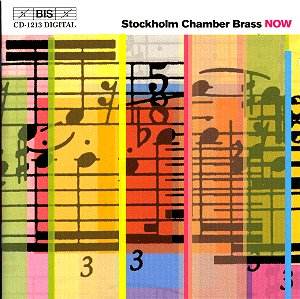The first track on this disc contains the most remarkable
new sound I’ve heard from an instrumental
ensemble for a very long time. Anders Hillborg,
in his Brass Quintet of 1998, asks the players to play ‘back to
front’, that is to imitate the sound of a recording being
played backwards. This effect is carried
off with almost incredible skill by the Stockholm Chamber
Brass, for whom the work, along with most of the music on
this disc, was written.
Hillborg’s piece is atmospheric and entertaining. The
very opening may bring police sirens to mind,
with its minor thirds passing rapidly from instrument to
instrument, and this interval becomes an important element
in the quintet, giving the whole work a playful
feeling. This is further supported by other elements
such as the ticking repeated notes, the perky fanfares, and of course
the ‘back-to-front’ music.
The Estonian composer Eino Tamberg is represented by
a very different, though equally impressive
piece. Music for Five is a rather uneasy work, beginning
with static chords that remind one of Stravinsky (in the
Symphonies of Wind Instruments for example). This
is the longest and most complex work on the
disc, and it develops with scurrying, furtive music
alternating with moments of an almost sentimental sweetness.
The variety of styles on this CD is remarkable, and the next piece,
Per Mårtensson’s I-Ching Variations, combines the brass
instruments with ‘live’ electronics in a highly
effective way. The sense of space and perspective is wonderful, and
the recording has enhanced this, allowing
the brass players momentarily to sound from
afar off, then to be suddenly closer again.
Poul Ruders, the Danish composer, has one of the most
distinctive voices amongst today’s European composers, and he constantly
explores those uncomfortable little places where different styles of
music meet – though ‘crossover’ to me is far too glib a description
for this quirky, elusive music. Break Dance is a clever title,
for while the music evokes the explosive movements of break dancing,
another meaning gradually emerges; the dancing rhythm of the music is
‘broken’, and struggles to achieve any kind of sustained rhythmic cohesion
throughout the duration of the piece, some seven and a half minutes.
Disconcerting, but intriguing and very cunning.
Berio is the most celebrated composer on the disc,
and his Call of 1985 is a typically enigmatic utterance – pithy
but endlessly resourceful, using not only the textural possibilities
of the brass instruments, but the players voices directed through their
instruments, a subtle and unearthly effect.
Berio’s little piece is not the only on on the disc
to require the players to use their voices. Joakim Agnas’ Tango,
which starts with what I take to be a verbal ‘count-in’, develops
into a grotesque but attractive version of the moody dance. It’s an
unassuming enough piece, but not without its delights; the use of the
tuba in particular is superbly effective, and Jonas Bylund produces
a splendidly decadent trombone solo.
The disc is completed by two pieces by very young composers;
Yong-Won Sung is in his mid twenties, and was born in South Korea, moving
to Germany in 1993. His Pandragon – the title refers to a ‘magical
realm where high technology and nature coexist’ according to the composer
– is another highly-strung, fragmented piece, in which different types
of tone production are experimented with, such as pitch distortion and
wide vibrato. There is also much use of multiple tonguing in the climactic
central section. An impressive piece, particularly from so young a writer.
Fredrik Högberg’s Melancholy Tango is the
third work to employ a vocal element, and does so extensively and imaginatively.
The players have to sing, echoing each other’s notes, and it’s a good
job the members of SCB are such efficient vocalists – I’m quite sure
that not all brass groups would manage so well! And of course having
a woman in their midst (trumpeter Tora Thorslund) does help for the
higher sung notes. This is a most attractive piece, though its relationship
to the tango style is far less overt than that of Agnas’ piece.
As you may have noticed, I’ve said more about the music
itself than the performances. That’s because the SCB is such an awesomely
talented and accomplished group. Not only their technique, but all aspects
of their ensemble playing make these extremely difficult modern works
sound effortless, thus directing your attention to their quality and
expressiveness rather than their uncompromising modernity. It’s also
a worthwhile reminder of how much mileage there still is in ‘conventional’
musical instruments, especially when used as unconventionally and imaginatively
as here. A superb issue, and I’ll be looking out keenly for the group’s
next venture.
Gwyn Parry-Jones


